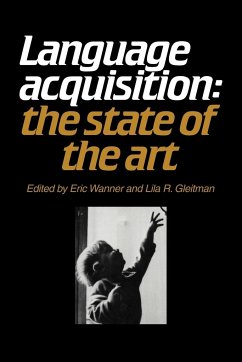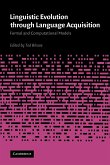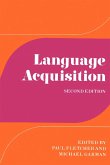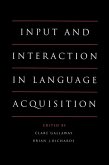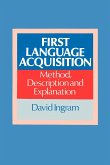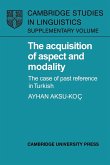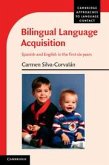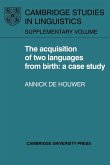Language Acquisition
The State of the Art
Herausgeber: Wanner, Eric; Gleitman, Lilar; Gleitman, Lila R.
Language Acquisition
The State of the Art
Herausgeber: Wanner, Eric; Gleitman, Lilar; Gleitman, Lila R.
- Broschiertes Buch
- Merkliste
- Auf die Merkliste
- Bewerten Bewerten
- Teilen
- Produkt teilen
- Produkterinnerung
- Produkterinnerung
This book offers a comprehensive study of language development.
Andere Kunden interessierten sich auch für
![Linguistic Evolution Through Language Acquisition Linguistic Evolution Through Language Acquisition]() Linguistic Evolution Through Language Acquisition43,99 €
Linguistic Evolution Through Language Acquisition43,99 €![Language Acquisition Language Acquisition]() Paul Fletcher / Michael Garman (eds.)Language Acquisition80,99 €
Paul Fletcher / Michael Garman (eds.)Language Acquisition80,99 €![Input and Interaction in Language Acquisition Input and Interaction in Language Acquisition]() Clare Gallaway / J. Richards (eds.)Input and Interaction in Language Acquisition51,99 €
Clare Gallaway / J. Richards (eds.)Input and Interaction in Language Acquisition51,99 €![First Language Acquisition First Language Acquisition]() David IngramFirst Language Acquisition92,99 €
David IngramFirst Language Acquisition92,99 €![The Acquisition of Aspect and Modality The Acquisition of Aspect and Modality]() Ayhan Aksu-KoThe Acquisition of Aspect and Modality58,99 €
Ayhan Aksu-KoThe Acquisition of Aspect and Modality58,99 €![Bilingual Language Acquisition Bilingual Language Acquisition]() Carmen Silva-CorvalánBilingual Language Acquisition33,99 €
Carmen Silva-CorvalánBilingual Language Acquisition33,99 €![The Acquisition of Two Languages from Birth The Acquisition of Two Languages from Birth]() Annick De HouwerThe Acquisition of Two Languages from Birth77,99 €
Annick De HouwerThe Acquisition of Two Languages from Birth77,99 €-
-
-
Produktdetails
- Produktdetails
- Verlag: Cambridge University Press
- Seitenzahl: 544
- Erscheinungstermin: 21. August 2009
- Englisch
- Abmessung: 229mm x 152mm x 32mm
- Gewicht: 873g
- ISBN-13: 9780521282383
- ISBN-10: 0521282381
- Artikelnr.: 27064927
- Herstellerkennzeichnung
- Libri GmbH
- Europaallee 1
- 36244 Bad Hersfeld
- gpsr@libri.de
- Verlag: Cambridge University Press
- Seitenzahl: 544
- Erscheinungstermin: 21. August 2009
- Englisch
- Abmessung: 229mm x 152mm x 32mm
- Gewicht: 873g
- ISBN-13: 9780521282383
- ISBN-10: 0521282381
- Artikelnr.: 27064927
- Herstellerkennzeichnung
- Libri GmbH
- Europaallee 1
- 36244 Bad Hersfeld
- gpsr@libri.de
List of contributors; Preface; Part I. The Logic of Language Acquisition:
1. Language acquisition: the state of the state of the art Lila R. Gleitman
and Eric Wanner; Part II. Preconditions for Language Acquisition: 2. The
resilience of recursion: a study of a communication system developed
without a conventional language model Susan Goldin-Meadow; 3. Why short
subjects are harder to find than long ones Charles Read and Peter
Schreiber; 4. On mechanisms of language acquisition: can features of the
communicative environment account for development? Marilyn Shatz; 5.
Universal and particular in the acquisition of language Dan I. Slobin; Part
III. The Development of Grammar: 6. Functionalist approaches to grammar
Elizabeth Bates and Brian MacWhinney; 7. On what cases categories there
are, why they are, and how they develop: an amalgam of a priori
considerations, speculation and evidence from children Martin D. S. Braine
and Judith A. Hardy; 8. The child's construction of grammatical categories
Michael Maratsos; 9. The role of universals in the acquisition of gerunds
Thomas Roeper; 10. A principle theory for language acquisition Kenneth
Wexler; Part IV. Semantic and Lexical Development: 11. Reorganisational
processes in lexical and syntactic development Melissa Bowerman; 12.
Semantic development: the state of the art Susan Carey; 13. The young word
maker: a case study of innovation in the child's lexicon Eve V. Clark; Part
V. Alternative Conceptions of Acquisition: 14. Some implications of the
nonspecific bases of language T. G. Bever; 15. Task specificity in language
learning? Evidence from speech perception and American Sign Language Elissa
L. Newport; References; Index.
1. Language acquisition: the state of the state of the art Lila R. Gleitman
and Eric Wanner; Part II. Preconditions for Language Acquisition: 2. The
resilience of recursion: a study of a communication system developed
without a conventional language model Susan Goldin-Meadow; 3. Why short
subjects are harder to find than long ones Charles Read and Peter
Schreiber; 4. On mechanisms of language acquisition: can features of the
communicative environment account for development? Marilyn Shatz; 5.
Universal and particular in the acquisition of language Dan I. Slobin; Part
III. The Development of Grammar: 6. Functionalist approaches to grammar
Elizabeth Bates and Brian MacWhinney; 7. On what cases categories there
are, why they are, and how they develop: an amalgam of a priori
considerations, speculation and evidence from children Martin D. S. Braine
and Judith A. Hardy; 8. The child's construction of grammatical categories
Michael Maratsos; 9. The role of universals in the acquisition of gerunds
Thomas Roeper; 10. A principle theory for language acquisition Kenneth
Wexler; Part IV. Semantic and Lexical Development: 11. Reorganisational
processes in lexical and syntactic development Melissa Bowerman; 12.
Semantic development: the state of the art Susan Carey; 13. The young word
maker: a case study of innovation in the child's lexicon Eve V. Clark; Part
V. Alternative Conceptions of Acquisition: 14. Some implications of the
nonspecific bases of language T. G. Bever; 15. Task specificity in language
learning? Evidence from speech perception and American Sign Language Elissa
L. Newport; References; Index.
List of contributors; Preface; Part I. The Logic of Language Acquisition:
1. Language acquisition: the state of the state of the art Lila R. Gleitman
and Eric Wanner; Part II. Preconditions for Language Acquisition: 2. The
resilience of recursion: a study of a communication system developed
without a conventional language model Susan Goldin-Meadow; 3. Why short
subjects are harder to find than long ones Charles Read and Peter
Schreiber; 4. On mechanisms of language acquisition: can features of the
communicative environment account for development? Marilyn Shatz; 5.
Universal and particular in the acquisition of language Dan I. Slobin; Part
III. The Development of Grammar: 6. Functionalist approaches to grammar
Elizabeth Bates and Brian MacWhinney; 7. On what cases categories there
are, why they are, and how they develop: an amalgam of a priori
considerations, speculation and evidence from children Martin D. S. Braine
and Judith A. Hardy; 8. The child's construction of grammatical categories
Michael Maratsos; 9. The role of universals in the acquisition of gerunds
Thomas Roeper; 10. A principle theory for language acquisition Kenneth
Wexler; Part IV. Semantic and Lexical Development: 11. Reorganisational
processes in lexical and syntactic development Melissa Bowerman; 12.
Semantic development: the state of the art Susan Carey; 13. The young word
maker: a case study of innovation in the child's lexicon Eve V. Clark; Part
V. Alternative Conceptions of Acquisition: 14. Some implications of the
nonspecific bases of language T. G. Bever; 15. Task specificity in language
learning? Evidence from speech perception and American Sign Language Elissa
L. Newport; References; Index.
1. Language acquisition: the state of the state of the art Lila R. Gleitman
and Eric Wanner; Part II. Preconditions for Language Acquisition: 2. The
resilience of recursion: a study of a communication system developed
without a conventional language model Susan Goldin-Meadow; 3. Why short
subjects are harder to find than long ones Charles Read and Peter
Schreiber; 4. On mechanisms of language acquisition: can features of the
communicative environment account for development? Marilyn Shatz; 5.
Universal and particular in the acquisition of language Dan I. Slobin; Part
III. The Development of Grammar: 6. Functionalist approaches to grammar
Elizabeth Bates and Brian MacWhinney; 7. On what cases categories there
are, why they are, and how they develop: an amalgam of a priori
considerations, speculation and evidence from children Martin D. S. Braine
and Judith A. Hardy; 8. The child's construction of grammatical categories
Michael Maratsos; 9. The role of universals in the acquisition of gerunds
Thomas Roeper; 10. A principle theory for language acquisition Kenneth
Wexler; Part IV. Semantic and Lexical Development: 11. Reorganisational
processes in lexical and syntactic development Melissa Bowerman; 12.
Semantic development: the state of the art Susan Carey; 13. The young word
maker: a case study of innovation in the child's lexicon Eve V. Clark; Part
V. Alternative Conceptions of Acquisition: 14. Some implications of the
nonspecific bases of language T. G. Bever; 15. Task specificity in language
learning? Evidence from speech perception and American Sign Language Elissa
L. Newport; References; Index.

